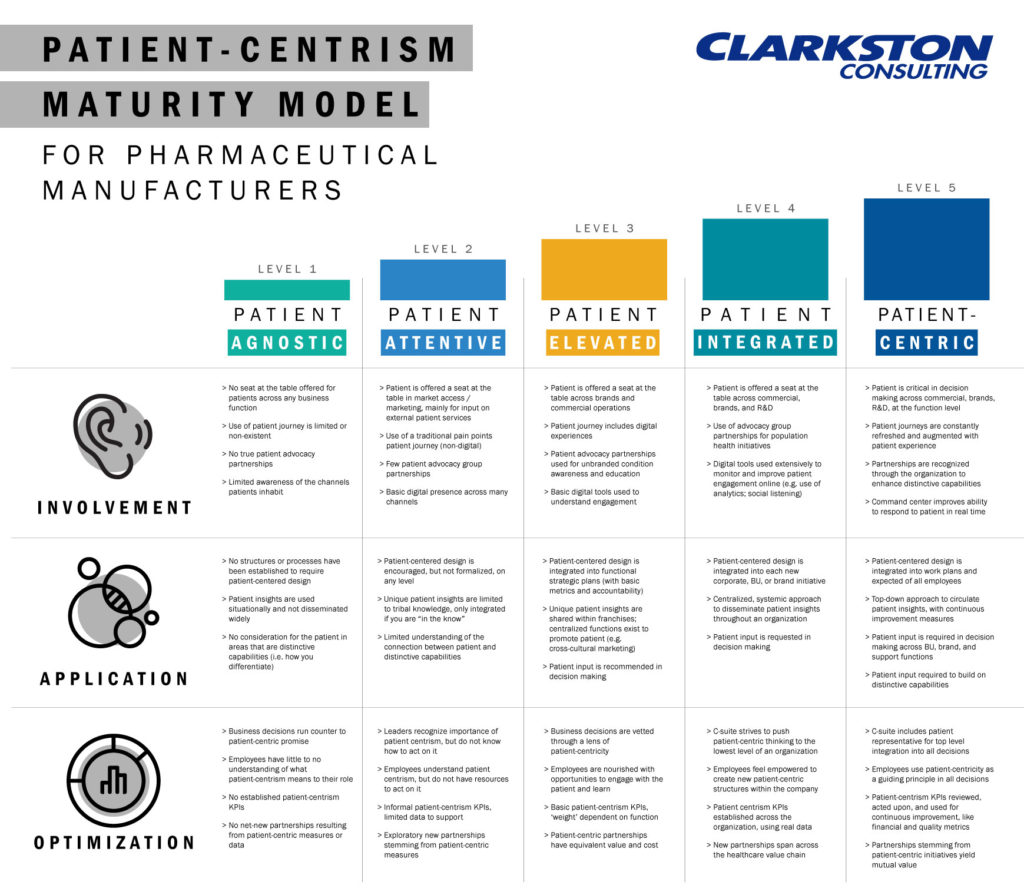Patient-Centered Care: A Model for Pharma’s Future
Just like the design-thinking revolution in software, we are in the midst of a patient-centered care revolution in healthcare. For pharmaceutical manufacturers, effective development and scaling of patient-centric measures holds an important key to unlocking a successful transition towards value-based care.
Healthcare companies of all kinds have begun to recognize that patient-centrism is not only the right thing to do for their customer, but it is a smart business decision. Channels for feedback help to address challenges earlier, formalized structures allow ideas to flow throughout an organization, and crowdsourcing patient ideas helps to ensure they understand what ‘a better outcome’ really looks like.
Health systems and insurance were the first to scale these types of measures, leaning on their close proximity and mass interactions with patients. Now, manufacturers are pushing harder than ever before to put the patient at the center of their world as well. With all of these exciting developments, we asked ourselves: what will patient-centricity look like in 2020 for life science manufacturers?
Three critical areas of transformation:
1. Involvement:
The first step to becoming patient-centric is creating mechanisms to capture real patient and caregiver experiences. This is more than just market insights or traditional patient research – truly considering what the patient encounters.
- Create formalized mechanisms for input: Patients perspectives will be welcomed (and required) in the groups and committees that make critical decisions in the organization. For example, patients will have a seat at the table for decisions related to research, market access, and marketing.
- Utilize individualized data to augment the narrative: Best-in-class companies will seek to understand what an improved outcome actually means for patients on a more individualized level. Manufacturers must understand how to collect and frame patient and caregiver’s needs, feelings, and experiences.
- Strengthen patient advocacy partnerships: The industry’s best companies have deep roots in advocacy groups in order to create a two-way street for information. Traditional push models (use the forum to provide education) must evolve to include pull of valuable patient needs information, which can then be used to make patient initiatives more robust.
- Meet patients and caregivers where they are: Manufacturers must engage with patients and learn from the patient in the channels they select. Effective engagement must avoid any new steps for the patient to take. Modern technology allows companies to monitor, aggregate, and analyze enormous amounts of data. Attempting to “bring the patient to them” is not taking advantage of methods available to become truly patient-centric.
2. Application:
The second step is to translate the patient and caregiver experiences into internal initiatives, programs, and learnings that will improve offerings and drive better outcomes. The key is to focus on solving the problems your patient has, and making this your primary focus. Use your treatment, mixed with innovations beyond the pill to accomplish this.
- Institutionalize structures and processes to utilize data: All business functions should be plugged into the data described above, not just those that are traditionally customer-facing. Finding novel ways to integrate this data into the day-to-day operations is an innovation challenge, but it’s required for companies that seek to lead in patient-centricity. For example, the best companies utilize information gained in the design of future clinical trials so that endpoints and objectives are aligned with the interests of the patient community.
- Disseminate, communicate, and integrate: Data can only be used to drive improved outcomes if it is appropriately spread throughout an organization. Manufacturers must create structures to disseminate information and integrate patient-centrism as a role requirement for every level in the company. This should be revisited and reinforced frequently (e.g. quarterly reviews, team formation meetings, etc.).
- Ensure the seats at the table have weight: The first step was creating a seat at the table for patients. Pharma has tried this in the past. To make it stick, balances need to be developed to ensure that the patient role isn’t eclipsed by the traditional decision makers. Best-in-class organizations will create a role with a direct line to the CEO with the remit to further elevate the perspective of the patient (for example, the Chief Patient Officer at Sanofi).
- Hyper-focus where capabilities are differentiating: The most critical place to seek patient input is where capabilities are distinctive (i.e. how you differentiate). As services become more homogenous, patient-centrism is critical to push the boundaries where you have chosen to differentiate. Change in the DNA of the business can be the most challenging to enact but can also yield the greatest rewards.
3. Optimization:
The final step is to use learnings from the prior two steps to enhance your input mechanisms and drive improvement in how you apply the information to improve outcomes.
- Create the patient-centric C-Suite: Just like every other transformation it all starts with a common, shared, and specific vision from the top. The C-suite of a successful company must be patient-obsessed regardless of their functional role. This not only communicates the desired behavior to the organization but also helps to ensure that top leaders do not make business decisions that run counter to your commitment to the patient (ruining trust).
- Create employee-patient stewardship: Be tactical to ensure that everyone is rowing in the same direction and is constantly reminded of the importance of patient-centrism to the company, and in their role. Integrate this deep into performance metrics and people practices. Tactical practices work. For example – every employee who joins LEO pharma meets a patient as part of induction.
- Create and utilize patient-centrism KPIs: Just like anything else, monitoring progress across quantifiable goals and metrics will help to improve performance. These should become as important as quality or financial metrics in an organization. The key is asking the right questions to track, then determining how each business function should ladder up to improve patient-centricity. It is also low hanging fruit and a great way to get started.
- Form partnerships with social and economic value: Lastly, your organization is more valuable with the information and internal structures to put it to use. Take learnings and form better partnerships. It becomes a virtuous cycle, as pharma can better tool actions with patient needs and shared goals can be realized. Partner types include pharmacy networks, HCP networks, advisory boards, digital health, and government.
The Bottom Line
The pharmaceutical companies that truly strive to become more patient-centric every day will find new ways to delight their customers and improve trust with industry partners. Patient centrism is not a promotional activity. It also cannot be viewed through a solely financial lens. It requires a transformation of the frame of reference through which a company operates.
Other companies in the healthcare spectrum are also striving to transform themselves. Look no further than the much-discussed CVS/Aetna bid, and you will see two companies trying to create a new route to greater patient-centricity. The tie-up stands to bring insurers and patients closer together than before possible. Similarly, manufacturers will need to find their own methods to break through what’s considered “industry normal” to cement the patient at the center of their universe.
To that end, modern patient-centrism requires bold leadership and action. As @Paul Garrison, President of Clarkston Consulting has said, “The best leaders in transformational change have a bias towards action”. If patient centrism is one of your goals, we are here to help. Clarkston offers strategy, operations, and technology solutions as well as leadership coaching and workshops to assist companies in becoming best in class.




